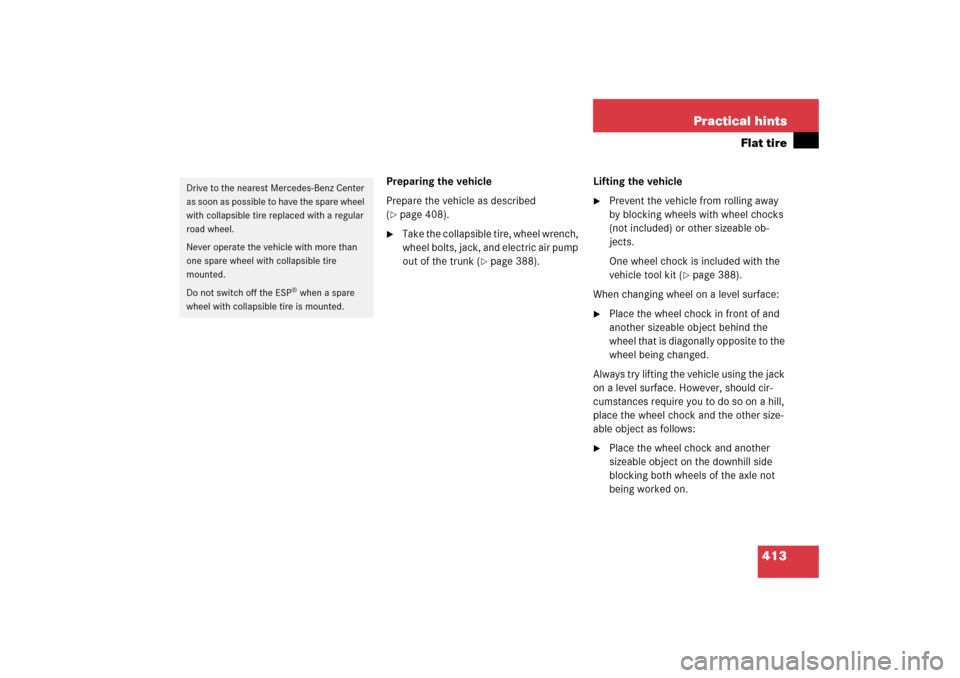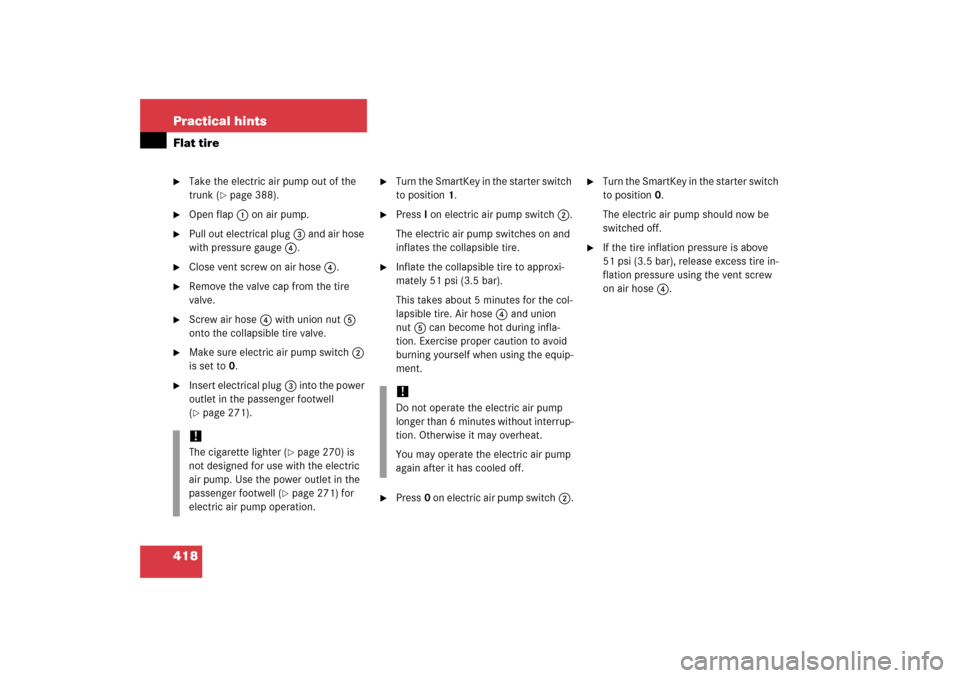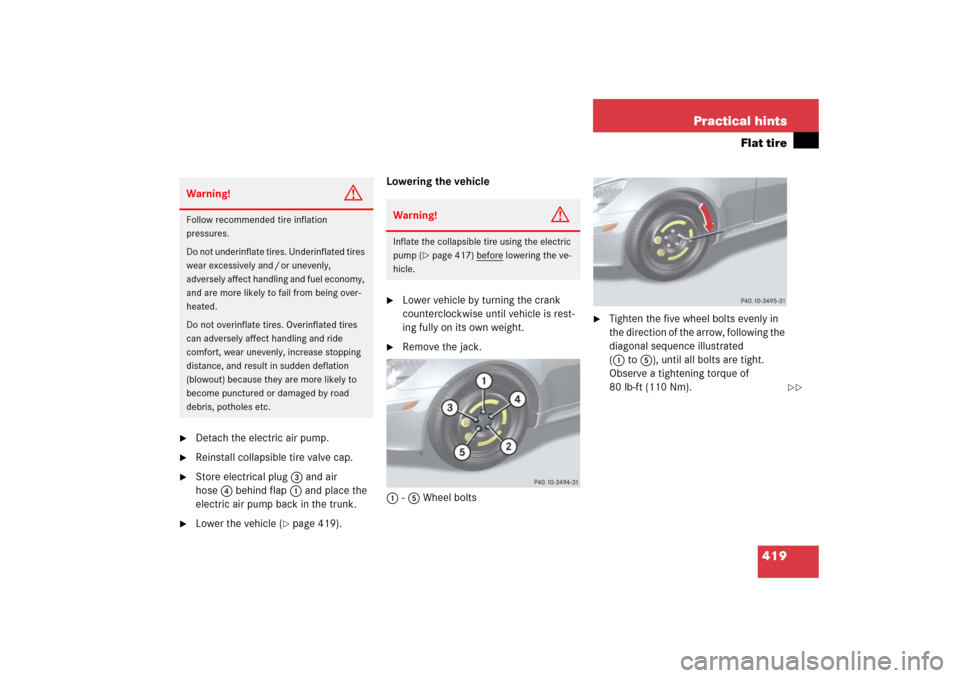Page 414 of 481

413 Practical hints
Flat tire
Preparing the vehicle
Prepare the vehicle as described
(�page 408).
�
Take the collapsible tire, wheel wrench,
wheel bolts, jack, and electric air pump
out of the trunk (
�page 388).Lifting the vehicle
�
Prevent the vehicle from rolling away
by blocking wheels with wheel chocks
(not included) or other sizeable ob-
jects.
One wheel chock is included with the
vehicle tool kit (
�page 388).
When changing wheel on a level surface:
�
Place the wheel chock in front of and
another sizeable object behind the
wheel that is diagonally opposite to the
wheel being changed.
Always try lifting the vehicle using the jack
on a level surface. However, should cir-
cumstances require you to do so on a hill,
place the wheel chock and the other size-
able object as follows:
�
Place the wheel chock and another
sizeable object on the downhill side
blocking both wheels of the axle not
being worked on.
Drive to the nearest Mercedes-Benz Center
as soon as possible to have the spare wheel
with collapsible tire replaced with a regular
road wheel.
Never operate the vehicle with more than
one spare wheel with collapsible tire
mounted.
Do not switch off the ESP
® when a spare
wheel with collapsible tire is mounted.
Page 419 of 481

418 Practical hintsFlat tire�
Take the electric air pump out of the
trunk (
�page 388).
�
Open flap1 on air pump.
�
Pull out electrical plug3 and air hose
with pressure gauge4.
�
Close vent screw on air hose4.
�
Remove the valve cap from the tire
valve.
�
Screw air hose4 with union nut5
onto the collapsible tire valve.
�
Make sure electric air pump switch2
is set to0.
�
Insert electrical plug3 into the power
outlet in the passenger footwell
(�page 271).
�
Turn the SmartKey in the starter switch
to position1.
�
PressI on electric air pump switch2.
The electric air pump switches on and
inflates the collapsible tire.
�
Inflate the collapsible tire to approxi-
mately 51 psi (3.5 bar).
This takes about 5 minutes for the col-
lapsible tire. Air hose4 and union
nut5 can become hot during infla-
tion. Exercise proper caution to avoid
burning yourself when using the equip-
ment.
�
Press0 on electric air pump switch2.
�
Turn the SmartKey in the starter switch
to position0.
The electric air pump should now be
switched off.
�
If the tire inflation pressure is above
51 psi (3.5 bar), release excess tire in-
flation pressure using the vent screw
on air hose4.
!The cigarette lighter (
�page 270) is
not designed for use with the electric
air pump. Use the power outlet in the
passenger footwell (
�page 271) for
electric air pump operation.
!Do not operate the electric air pump
longer than 6 minutes without interrup-
tion. Otherwise it may overheat.
You may operate the electric air pump
again after it has cooled off.
Page 420 of 481

419 Practical hints
Flat tire
�
Detach the electric air pump.
�
Reinstall collapsible tire valve cap.
�
Store electrical plug3 and air
hose4 behind flap 1 and place the
electric air pump back in the trunk.
�
Lower the vehicle (
�page 419).Lowering the vehicle
�
Lower vehicle by turning the crank
counterclockwise until vehicle is rest-
ing fully on its own weight.
�
Remove the jack.
1-5 Wheel bolts
�
Tighten the five wheel bolts evenly in
the direction of the arrow, following the
diagonal sequence illustrated
(1to5), until all bolts are tight.
Observe a tightening torque of
80 lb-ft (110 Nm).
Warning!
G
Follow recommended tire inflation
pressures.
Do not underinflate tires. Underinflated tires
wear excessively and / or unevenly,
adversely affect handling and fuel economy,
and are more likely to fail from being over-
heated.
Do not overinflate tires. Overinflated tires
can adversely affect handling and ride
comfort, wear unevenly, increase stopping
distance, and result in sudden deflation
(blowout) because they are more likely to
become punctured or damaged by road
debris, potholes etc.
Warning!
G
Inflate the collapsible tire using the electric
pump (
�page 417) before
lowering the ve-
hicle.
��
Page 421 of 481
420 Practical hintsFlat tire
�
Fully collapse the jack.
�
Place the vehicle tool kit, electric air
pump, and the jack back in the storage
compartment underneath the trunk
floor.
�
Wrap the damaged wheel in the protec-
tive sheet provided with the spare
wheel and put the wheel in the trunk.
Warning!
G
Have the tightening torque checked after
changing a wheel. The wheels could come
loose if they are not tightened to a torque of
80 lb-ft (110 Nm).
iThe flat tire may be transported in the
trunk when the retractable hardtop is
closed.
��
Page 429 of 481

428 Practical hintsTowing the vehicleInstalling towing eye bolt
The towing eye bolt is supplied with the ve-
hicle tool kit, located in the compartment
underneath the trunk floor (
�page 388).
The towing eyes are located on the passen-
ger side in the front and rear bumper.
�
Take vehicle tool kit out of trunk
(�page 388).Front cover
1Cover in front bumper
Removing
�
Press mark on cover1.
�
Cover1 springs open at the top right
corner.
�
Pull at the protruding part of cover1
and fold cover down to reveal the
threaded hole for the towing eye bolt.
Do not disconnect cover1 from its
check strap.
�
Screw towing eye bolt in to its end stop
and tighten with lug wrench.Installing
�
Unscrew the towing eye bolt using the
lug wrench.
�
To reinstall cover1, tilt the marked
lower left corner towards the opening.
�
Maintaining its tilted position, insert
cover1 by applying the latches at the
top left and lower right corner into the
opening.
�
To close cover1, press on the diago-
nal opposite side of the marked corner
until it fully engages.
iThe gear selector lever* will remain
locked in positionP (vehicles with au-
tomatic transmission*) and the
SmartKey will not turn in the starter
switch if the battery is disconnected or
discharged. See notes on the battery
(�page 421) or on jump starting
(�page 424).
Vehicles with automatic transmission*:
For information on manual unlocking of
gear selector lever, see (
�page 396).
iMake sure the cover’s check strap
does not get caught when closing.
Page 449 of 481
448 Technical dataWeightsModel
SLK 280
SLK 350
SLK 55 AMG
Maximum roof load
110lb (50kg)
110lb (50kg)
Maximum trunk load
220 lb (100 kg)
220 lb (100 kg)
!This vehicle is not designed to carry
items on its roof. Roof rails and any
roof-mounted devices, unless express-
ly approved by Mercedes-Benz for use
on this vehicle model, must not be used
as they will damage the vehicle and
retractable hardtop.
At time of printing, Mercedes-Benz
does not offer any roof racks or any
other roof-mounted devices for use on
this vehicle.
!This vehicle is not designed to carry
any items on its trunk lid or accommo-
date any type of trunk lid rack or de-
vice. Using such devices may damage
the vehicle and retractable hardtop
mechanism.
Page 462 of 481

461 Technical terms
Power train
Collective term designating all compo-
nents used to generate and transmit
motive power to the drive axles, includ-
ing
�
Engine
�
Clutch/torque converter
�
Transmission
�
Transfer case
�
Drive shaft
�
Differential
�
Axle shafts/axles
Production options weight
(
�page 345)Program mode selector switch*
Used to switch the automatic transmis-
sion between standard operation (S)
and comfort operation (C).
Vehicles with steering wheel gearshift
control and manual shift program: in
addition toS andC (for regularS
or comfortC operation, see above),
you can useM for manual shift pro-
gram.
PSI
(P
ounds per s
quare i
nch)
(
�page 345)
Recommended tire inflation pressure
(�page 345)REST
(Residual engine heat utilization)
Feature that uses the engine heat
stored in the coolant to heat the vehi-
cle interior for a short time after the en-
gine has been turned off.
Restraint systems
Seat belts, belt tensioners, air bags
and child restraint systems. As inde-
pendent systems, their protective func-
tions complement one another.
Rim
(
�page 345)
Retractable hardtop
Hardtop that can be opened and closed
at the push of a button and stored in
the trunk.
Page 469 of 481

468 IndexDriver’s door
Locking in an emergency 395
Unlocking in an emergency 394
Driving 53
Automatic transmission* 53
Driving off 296
Fuel saving 293
Hydroplaning 297
In winter 299
Instructions 47, 293
Manual transmission 53
Standing water 300
Tires 297
Traveling abroad 301
Driving safety systems 82
ABS 82
BAS 83
ESP
®
84E
Easy-entry/exit feature* 43, 148
Electric air pump 391
Electric air pump (Vehicle tool kit) 388
Electrical system (Technical data) 446
Electronic Stability Program see ESP
®
Emergency call (911) 243
Emergency call system 273
Tele Aid 275
Emergency operations
Automatic transmission* 172
Releasing trunk lid from inside 100
Remote door unlock (Tele Aid) 280
Retractable hardtop 397
Selector lever*, unlocking
manually 396
Unlocking/locking the vehicle 394
Emergency tensioning device see ETD
Emission control 302, 436
Engine
Cleaning see Vehicle care
Compartment 307
Driving after replacement 292
Number 436, 458
Technical data 438
Turning off 61Engine oil 308, 451
Adding 312
Additives 451
Checking level (Control system) 309
Checking level (Dipstick) 311
Consumption 308
Display message 310
Viscosity 458
ESP
®
84, 458
Display message 371
Warning lamp 365
ETD 73, 74, 459
Safety guidelines 68
Seat belt force limiter 74
Exterior lamp switch 110
Exterior lighting
Lamps 401
Replacing bulbs 401
Exterior rear view mirrors see Mirrors